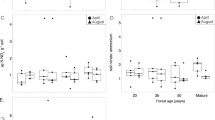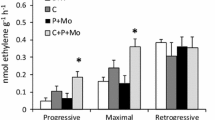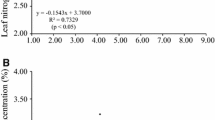Abstract
Nitrogen (N) fixed by termites was evaluated as a N input to decomposition processes in two tropical forests, a dry deciduous forest (DDF) and the neighboring dry evergreen forest (DEF), Thailand. A diverse group of termite species were assayed by acetylene reduction method and only the wood/litter-feeding termites were found to fix N. More intensive samplings of two abundant species, Microcerotermes crassus and Globitermes sulphureus, were done across several seasons, suggesting N fixation rates of 0.21 and 0.28 kg ha−1 y−1 by termites in the DDF and DEF, respectively. Also, estimates of asymbiotic N fixation rates were 0.75 and 3.95 kg ha−1 y−1. N fixed by termites and by asymbiotic fixers is directly supplied to decomposers breaking down dead plant material and could be a major source of their N. N fixed by termites was 7–22% of that fixed by termites and asymbiotic fixers. Although N fixed by termites is a small input compared to other inputs, this N is likely important for decomposition processes.




Similar content being viewed by others
References
Abe T. 1980. Studies on the distribution and ecological role of termites in a lowland rain-forest of West Malaysia. 4. The role of termites in the process of wood decomposition in Pasoh-Forest-Reserve. Revue d’Ecologie et de Biologie du Sol 17:23–40
Benemann JR. 1973. Nitrogen fixation in termites. Science 181:164–5
Bentley BL. 1984. Nitrogen fixation in termites – fate of newly fixed nitrogen. J Insect Physiol 30:653–5
Bignell DE, Eggleton P. 2000. Termites in ecosystems. In: Abe T, Bignell DE, Higashi M, Eds. Termite: evolution, society, symbioses, ecology. Dordrecht: Kluwer Academic. p 363–87
Bignell DE, Eggleton P, Nunes L, Thomas KL. 1997. Termites as mediators of carbon fluxes in tropical forests: Budgets for carbon dioxide and methane emissions. In: Watt AD, Stork NE, Hunter MD, Eds. Forests and Insects. London: Chapman and Hall. p 109–34
Breznak JA. 1975. Symbiotic relationships between termites and their intestinal microbiota. In: Jennings DH, Lee DL, Eds. Symbiosis: 29th Symposium of the Society for Experimental Biology. Cambridge: Cambridge University Press. p 559–80
Breznak JA. 1982. Intestinal microbiota of termites and other xylophagous insects. Annu Rev Microbiol 36:323–43
Breznak JA, Brill WJ, Mertins JW, Coppel HC. 1973. Nitrogen fixation in termites. Nature 244:577–80
Cleveland CC, Townsend AR, Schimel DS, Fisher H, Howarth RW, Hedin LO, Perakis SS, Latty EF, Von Fischer JC, Elseroad A, Wasson MF. 1999. Global patterns of terrestrial biological nitrogen (N2) fixation in natural ecosystems. Glob Biogeochem Cycles 13:623–45
Collins NM. 1980. The distribution of soil macro fauna on the west ridge of Gunung Mount Mulu Sarawak. Oecologia 44:263–75
Curtis AD, Waller DA. 1997. Variation in rates of nitrogen fixation in termites: response to dietary nitrogen in the field and laboratory. Physiol Entomol 22:303–9
Curtis AD, Waller DA. 1998. Seasonal patterns of nitrogen fixation in termites. Funct Ecol 12:803–7
Edwards PJ. 1982. Studies of mineral cycling in a montane rain forest in New Guinea 5. Rates of cycling in throughfall and litter fall. J Ecol 70:807–28
Eggleton P. 2000. Global patterns of termite diversity. In: Abe T, Bignell DE, Higashi M, Eds. Termite: evolution, society, symbioses, ecology. Dordrecht: Kluwer Academic. p 25–51
Eggleton P, Bignell DE. 1995. Monitoring the response of tropical insects to changes in the environment: troubles with termites. In: Harrington R, Stork NE, Eds. Insects in a changing environment. London: Academic Press. p 478–97
Eggleton P, Homathevi R, Jones DT, MacDonald JA, Jeeva D, Bignell DE, Davies RG, Maryati M. 1999. Termite assemblages, forest disturbance and greenhouse gas fluxes in Sabah, East Malaysia. Philos Trans Roy Soc Lond B Biol Sci 354:1791–802
Fittkau EJ, Klinge H. 1973. On biomass and trophic structure of the central Amazonian rain forest ecosystem. Biotropica 5:2–14
Frey SD, Elliott ET, Paustian K, Peterson G. 2000. Fungal translocation as a mechanism of exogenous nitrogen inputs to decomposing surface residues in a no-tillage agroecosystem. Soil Biol Biochem 32:689–98
Hall JH, Matson PA. 2003. Nutrient status of tropical rain forests influences soil N dynamics after N additions. Ecol Monogr 73:107–29
Hardy RW, Burns RC, Holsten RD. 1973. Applications of the acetylene-ethylene assay for measurement of nitrogen fixation. Soil Biol Biochem 5:47–81
Hunt HW, Ingham ER, Coleman DC, Elliott ET, Reid CPP. 1988. Nitrogen limitation of production and decomposition in prairie mountain meadow and pine forest. Ecology 69:1009–16
Jordan CF. 1985. Nutrient Cycling in Tropical Forest Ecosystems: Principles and their Application in Management and Conservation. Chichester: John Wiley and Sons. 190 p
Konaté S, Le Roux X, Verdier B, Lepage M. 2003. Effect of underground fungus-growing termites on carbon dioxide emission at the point- and landscape-scales in an African savanna. Funct Ecol 17:305–14
Lovelock M, Obrien RW, Slaytor M. 1985. Effect of laboratory containment on the nitrogen metabolism of termites. Insect Biochem 15:503–10
Martius C. 1994. Diversity and ecology of termites in Amazonian forests. Pedobiologia 38:407–28
Nardi JB, Mackie RI, Dawson JO. 2002. Could microbial symbionts of arthropod guts contribute significantly to nitrogen fixation in terrestrial ecosystems? J Insect Physiol 48:751–63
Pandey S, Waller DA, Gordon AS. 1992. Variation in acetylene-reduction (nitrogen-fixation) rates in Reticulitermes spp. (Isoptera; Rhinotermitidae). VA J Sci 43:333–8
Prestwich GD, Bentley BL, Carpenter EJ. 1980. Nitrogen sources for Neotropical nasute termites Nasutitermes ephratae and Rhynchotermes perarmatus fixation and selective foraging. Oecologia 46:397–401
Rohrmann GF, Rossman AY. 1980. Nutrient strategies of Macrotermes ukuzii (Isoptera: Termitidae). Pedobiologia 20:61–73
Roisin Y. 2000. Diversity and evolution of caste patterns. In: Abe T, Bignell DE, Higashi M, Eds. Termite: evolution, society, symbioses, ecology. Dordrecht: Kluwer Academic. p 95–119
Schaefer DA, Whitford WG. 1981. Nutrient cycling by the subterranean termite Gnathamitermes tubiformans in a Chihuahuan desert ecosystem. Oecologia 48:277–83
Son Y. 2001. Non-symbiotic nitrogen fixation in forest ecosystems. Ecol Res 16:183–96
Strigel G, Ruhiyat D, Prayitno D, Sarmina S. 1994. Nutrient input by rainfall into secondary forests in East Kalimantan, Indonesia. J Trop Ecol 10:285–8
Sylvester-Bradley R, Bandeira AG, de Oliveira LA. 1978. Fixação de nitrogênio (redução de acetileno) em cupins (Insecta: Isoptera) da Amazônia Central. Acta Amazonica 8:621–7
Tayasu I, Sugimoto A, Wada E, Abe T. 1994. Xylophagous termites depending on atmospheric nitrogen. Naturwissenschaften 81:229–31
Vitousek PM, Cassman K, Cleveland C, Crews T, Field CB, Grimm NB, Howarth RW, Marino R, Martinelli L, Rastetter EB, Sprent JI. 2002. Towards an ecological understanding of biological nitrogen fixation. Biogeochemistry 57:1–45
Vitousek PM, Howarth RW. 1991. Nitrogen limitation on land and in the sea – How can it occur? Biogeochemistry 13:87–115
Waller DA. 2000. Nitrogen fixation by termite symbionts. In: Triplett EW, Ed. Prokaryotic nitrogen fixation: a model system for analysis of a biological process. Wymondham: Horizon Scientific Press. p 225–36
Waller DA, Breitenbeck GA, La Fage JP. 1989. Variation in acetylene-reduction by Coptotermes formosanus (Isoptera, Rhinotermitidae) related to nest source and termite size. Sociobiology 16:191–6
Wood TG, Sands WA. 1978. The role of termites in ecosystems. In: Brian MV, Ed. Production ecology of ants and termites. Cambridge: Cambridge University Press. p 245–92
Yamada A, Inoue T, Sugimoto A, Takematsu Y, Kumai T, Hyodo F, Fujita A, Tayasu I, Klangkaew C, Kirtibutr N, Kudo T, Abe T. 2003. Abundance and biomass of termites (Insecta: Isoptera) in dead wood in a dry evergreen forest in Thailand. Sociobiology 42:569–85
Acknowledgements
We thank the National Research Council of Thailand, the people who are working at Sakaerat Environmental Research Station, T. Johjima, Y. Hongoh, C. Boontong, S. Trakulnaleamsai, and N. Noparatnaraporn for their kind cooperation. We thank the chemical analysis section of RIKEN for the elemental analyses, M. B. Wamalwa, I. Tayasu, and two anonymous reviewers for their helpful comments on the manuscript, and A. Haraguchi and R. Araki for improving the English of the manuscript. This work was supported by Grant-in-Aid (09NP1501) for Creative Basic Research from Japan Ministry of Education, Culture, Sports, Science and Technology, and in part by grants from the Bioarchitect Research Program and the Eco Molecular Science Research Program from RIKEN. The first author (A. Y.) was also supported by a grant from the Junior Research Associate Program from RIKEN.
Author information
Authors and Affiliations
Corresponding author
Rights and permissions
About this article
Cite this article
Yamada, A., Inoue, T., Wiwatwitaya, D. et al. Nitrogen Fixation by Termites in Tropical Forests, Thailand. Ecosystems 9, 75–83 (2006). https://doi.org/10.1007/s10021-005-0024-7
Received:
Accepted:
Published:
Issue Date:
DOI: https://doi.org/10.1007/s10021-005-0024-7




